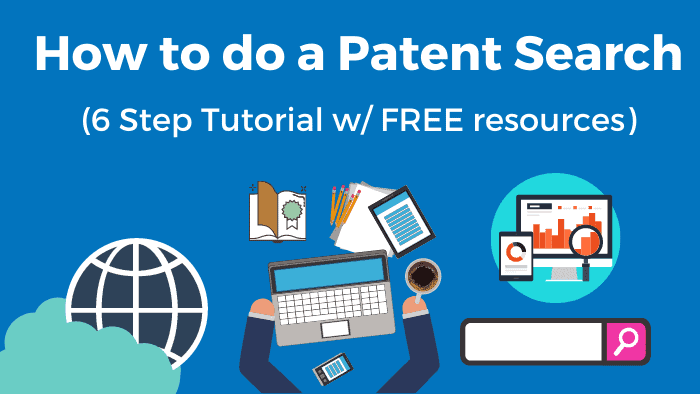Knowing how to do a patent search is probably the most challenging and daunting part of the patent process. It takes a rolling-up-the-sleeves attitude and a whole lot of passion to get it done right. There is nothing glamorous about the patent search process. It requires combing through hundreds—or even thousands—of publications to assess the merits of an invention.
On top of that, the process can be scary because there may be something similar to your invention already out there. Someone may have thought of it before.
It’s stressful, but important, to stop and do research before filing a patent application. The results of a professional patent search coupled with a legal opinion from a Patent Attorney is what every inventor and business owner/entrepreneur needs to receive (and fully comprehend) prior to moving forward with their invention and its application.
It’s a hard truth to face when your invention is not, in fact, all that new. Even harder to realize that there is very little room to innovate, the scope of rights is smaller than you imagined, and your unique selling proposition is diminished.
In this article, I’m going to outline the complete process on how our Patent Attorneys perform a patentability search. If watching is more your jam, check out this video I did on Patent Searching.
You can find additional blogs on How to Patent an Idea and How Much Does a Patent Cost on our blog page.
How to Do a Patent Search
STEP 1: Understand What a Patent Search is and What it is Not
It’s important to know what your goals are going into a patent search. It’s best to set expectations properly at the onset, so you’re not disappointed or confused at the end.
Understand the Difference between Patent Searches and Prior Art Searches
There is a difference between a patent search and a comprehensive prior-art search (which is needed for patentability). A patent search is what it sounds like, a search for patent documents that might have an impact on your invention. There is an entire world of non-patent documents that must be considered as part of the broader “prior art” when you perform your comprehensive search.
There are many good tutorials for conducting patent searches because there are order, classification systems, and findable domains. However, there is a much more organic/brute-force approach needed to assure you’ve uncovered non-patent literature (newspapers, magazines, dissertations, websites, etc.) sufficiently.
**NOTE** For simplicity’s sake, I use the term “patent search” throughout this article just because it’s the common phrase for it, and I’m trying to educate every inventor here – so I’m casting a wide net. Now, you’re on the inside, and you know that I mean “comprehensive prior art search” when I say “patent search”. Shhh, that’ll be our little secret.
Define the Goal of Your Patent Search
The goal of the patent search is to inform you, the inventor, about patentability. Patentability is the bigger – more important question that should be answered using the results of the patent search. A patentable invention is Eligible and has both Novelty and is Non-Obviousness. This means that the invention is an accepted subject matter (eligibility), is one-of-a-kind in the whole world (novelty), and that there have been no publications/patents that have suggested that it could be done (non-obviousness).
Translating the Results
After the patent search is done, you should analyze the results. If you’re working with a patent expert (like an attorney), they should also give you their legal opinion on the search. If
The real value of working with a patent attorney is the aforementioned legal opinion. After all, that’s what you are left with at the end. Instead of a (seemingly) endless list of prior art, you have a nice, clean professional opinion on what you should do. That’s worth gold.
Don’t Forget the Legal Opinion
A legal opinion is “gold”. With it, an inventor/entrepreneur can form a BUSINESS DECISION as to whether the risk of investment into the patent application will be worth it.
There are many ways you can conduct a patent search. Below are some options to consider. As you can see, the best option is to hire a Patent Attorney because they truly understand how to do a patent search.

Below is the equation for patentability:
PATENT SEARCH + LEGAL OPINION = PATENTABILITY
However, the brutal truth is: You can have the most patentable invention in the world, but it may not be commercially viable. If that’s the case, you won’t see success in the end.
Get Testing
Inventors need to join forces with others to test it, design it for the market, align manufacturing, package, and sell it. Even if you want to license or sell your invention, you’ll have to hustle, network, pitch, and proactively sell your invention to would-be licensees or buyers.
It’s that unique combination of a solid patent portfolio mixed with hustle and determination that is most likely to lead to a commercially-successful product. Every invention is a success in terms of technical improvement, but it is up to the inventor to “make it rain” if money or commercial success is what they are after.
It is critical to assess the market prior to investing money into any venture, especially one as time and capital-intensive as the patent process.
Here is the equation for how to get to marketability:
MARKET RESEARCH + BUSINESS OPINION = MARKETABILITY
The Ultimate Equation
Last but not least, the formula for making the best business decision is to follow a Patent Success Matrix that looks at both patentability and marketability.
PATENTABILITY + MARKETABILITY = SOUND BUSINESS DECISION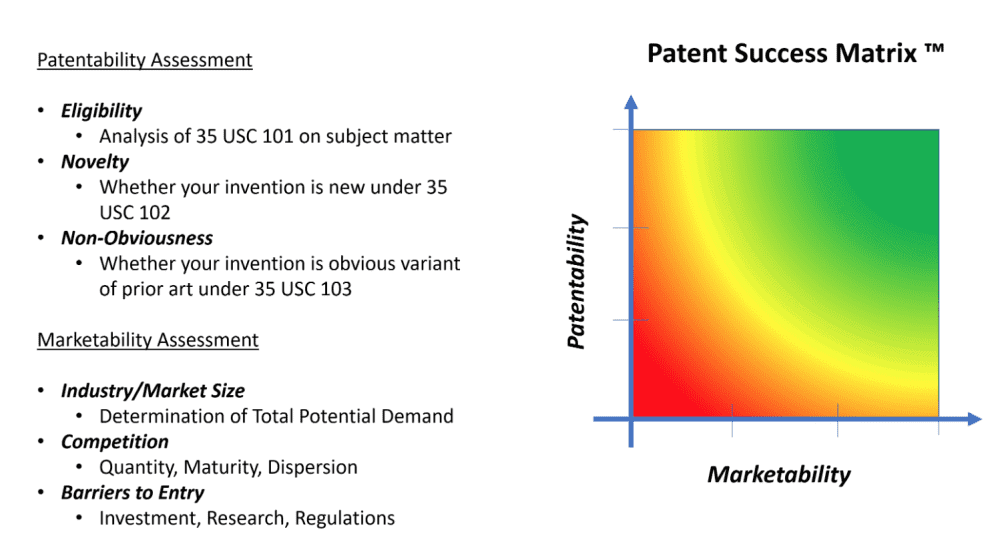
The Patent Success Matrix chart shows that you want to have an invention that is both patentable and marketable – See the Red X shown below: This means that your invention is not very patentable and the market demand is either too weak, or there are too many competitors or challenges with the industry (barriers). If your invention falls into one of the TWO blue X’s below, then you should expect to be successful, but you’ll have to push a bit harder than some.On the contrary, you do NOT want your invention to fall anywhere near the red or orange-colored areas of the chart (See Green X below):
This means that your invention is not very patentable and the market demand is either too weak, or there are too many competitors or challenges with the industry (barriers). If your invention falls into one of the TWO blue X’s below, then you should expect to be successful, but you’ll have to push a bit harder than some.On the contrary, you do NOT want your invention to fall anywhere near the red or orange-colored areas of the chart (See Green X below):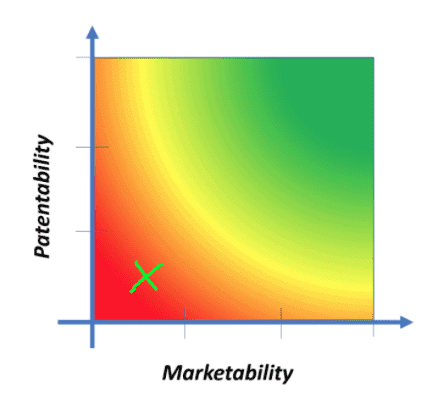
This means that your invention is not very patentable and the market demand is either too weak, or there are too many competitors or challenges with the industry (barriers). If your invention falls into one of the TWO blue X’s below, then you should expect to be successful, but you’ll have to push a bit harder than some.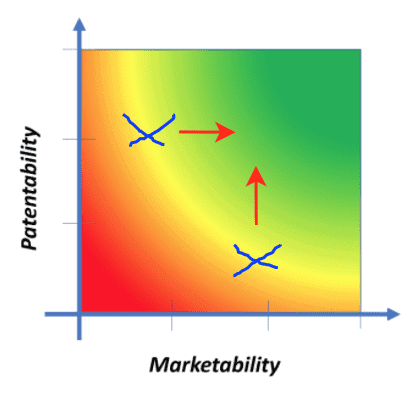
The upper blue “X” shows that your invention is quite creative and has a great chance of overcoming prior art objections/rejections. It will also have a nice scope of claims allowed. However, based on research, there isn’t very much demand for your product, or competition is pretty high. To have success (and move the arrow to the right into the green) with the upper blue “X”, you’ll have to find ways of overcoming the market trouble by out-marketing, coming up with innovative strategies for commercials, using celebrity power, etc. to try to break through. The lower blue “X” shows you have powerful market potential based on your research. You may truly be one of the only players in the market and there is strong demand for your product and price point is good! But the patent rights are narrow, and your claim scope is not as broad as you’d like. To have success (and move the arrow upward to green), you should consider filing other patents such as design patents, or further developing your portfolio with continuation patents/divisional patents to shore up your legal rights/protection over your technology.Now that you know what a patent search is, and where the patent search fits into the broader picture, it will help you understand where the information gathered in the search phase will be used in the next step.
STEP 2: Invention Disclosure Prior to a Patent Search
You only get out of it, what you put into it, right? Your Patent Attorney should understand the invention as well as you do before they conduct the search or opine on the results. Be sure to disclose to your Patent Attorney everything you’ve ever conceived relative to your invention, including how you plan to use it or monetize it. A good Patent Attorney will tease out the entire invention (and then some) by asking questions, seeking more information about certain aspects, functionality, or applications.At Bold Patents we use an Invention Disclosure Document form which goes through many questions about the invention itself, and gets the inventor thinking about alternative embodiments, or versions that may not be able to be implemented due to cost but that are available if money were no barrier. This process of expanding the invention looks to further define the following:
- Would the invention work better with different materials?
- What problems does your invention solve in other industries and how can it change to fit the needs of that product/solution?
- If state-of-the-art technology were implemented into the invention, could it solve new problems?
A generically described invention, that has only loosely described structure, ambiguous functionality and features will return a search result that is only surface-level and very difficult to discern when it comes time to form a legal opinion. A well-defined invention, on the other hand, is much more straightforward to search on and allows the Patent Attorney to do a deep dive search on the subject. Meaning, the better the inputs, the better the outputs. There is no doubt that inventions change over the course of representation with many clients, especially after an application is submitted and customers can give their feedback on a device/system. This is typical after filing a provisional patent application, and testing is done or customer feedback is sought. If the improvements are found after filing the nonprovisional patent application, you can always look to file a continuation patent application to capture new subject matter. Therefore, a subsequent search after making improvements is often necessary to assure that the improvements/changes in the invention are patentable.
The subsequent search will stand on the shoulders of the previous search, and so the higher quality the initial patent search, the better results for all future improvements of what will hopefully become a patent portfolio.
STEP 3: Identify 3-5 Key Features
Once the invention has been sufficiently disclosed, it can be boiled down to a small set of core features. The features can also be seen as functions. What are the core features of the invention? The quantity varies, but the fewer (than 5) the better. Identifying key features is essential to make sure that we cover all aspects of the invention, without duplicating effort. Each major feature will require a separate search inquiry to make sure that we cast a wide enough net. But we have a defined limit as to how many nets we cast and into what water. When identifying features, do not try to get too fancy. Just describe the essential features of the invention using natural language. You can use entire sentences as needed to fully identify each key element. Example: Feature 1: Straight Edge Cutting Guide with SlitFeature 2: Class two lever (alligator style) Cutting DeviceFeature 3: Height Adjustable Cutting DeviceHere, each major feature of this cutting device is identified in plain terms without going into too much detail. Again, the goal is to guide the search without directing it.
STEP 4:Begin Searching Broadly
For each of the defined key features, conduct a broad search using the Google Patents database (and Advanced Google Patent search), which is the best natural language search.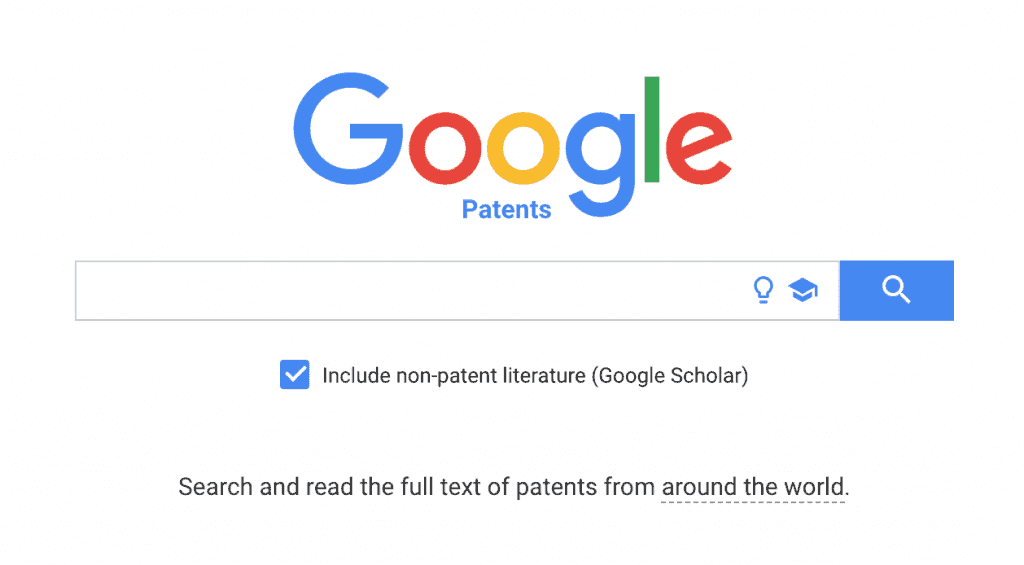 You will want to check the box “Include non-patent literature,” which will include journals, academic dissertations, thesis papers, newspapers, or other reports from around the world. You may need to wade through several pages of results before finding a patent document with a disclosure that is on point or similar to your feature. This is a very lengthy process and cannot be rushed. No less than 4 hours should be spent in this initial phase of research, where each primary element of your invention gets a dedicated natural language search. Here is an example search:
You will want to check the box “Include non-patent literature,” which will include journals, academic dissertations, thesis papers, newspapers, or other reports from around the world. You may need to wade through several pages of results before finding a patent document with a disclosure that is on point or similar to your feature. This is a very lengthy process and cannot be rushed. No less than 4 hours should be spent in this initial phase of research, where each primary element of your invention gets a dedicated natural language search. Here is an example search: 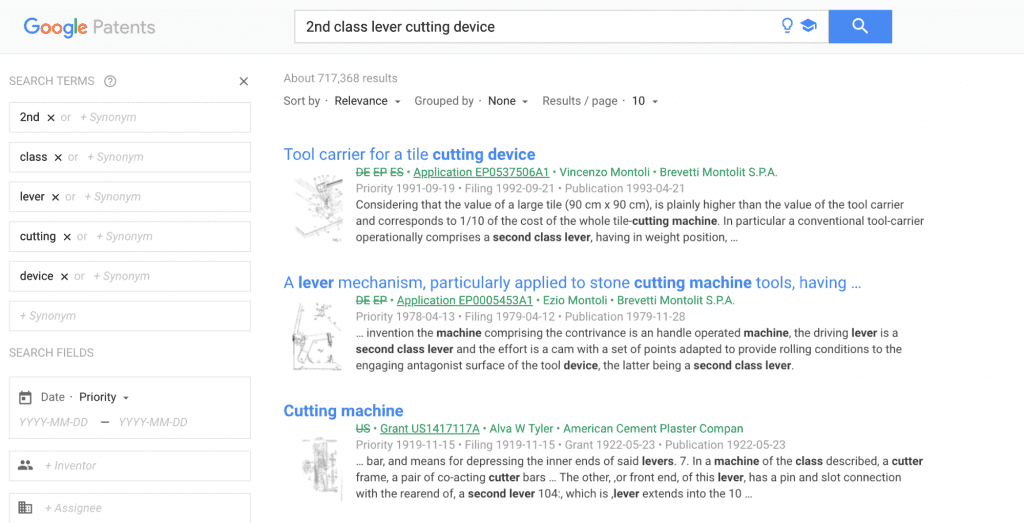
As you search and use different natural language keywords and phrases, make sure to use Boolean search strings to aid in refining searches to help you hone in on the feature of interest. Here is a table of Boolean searches: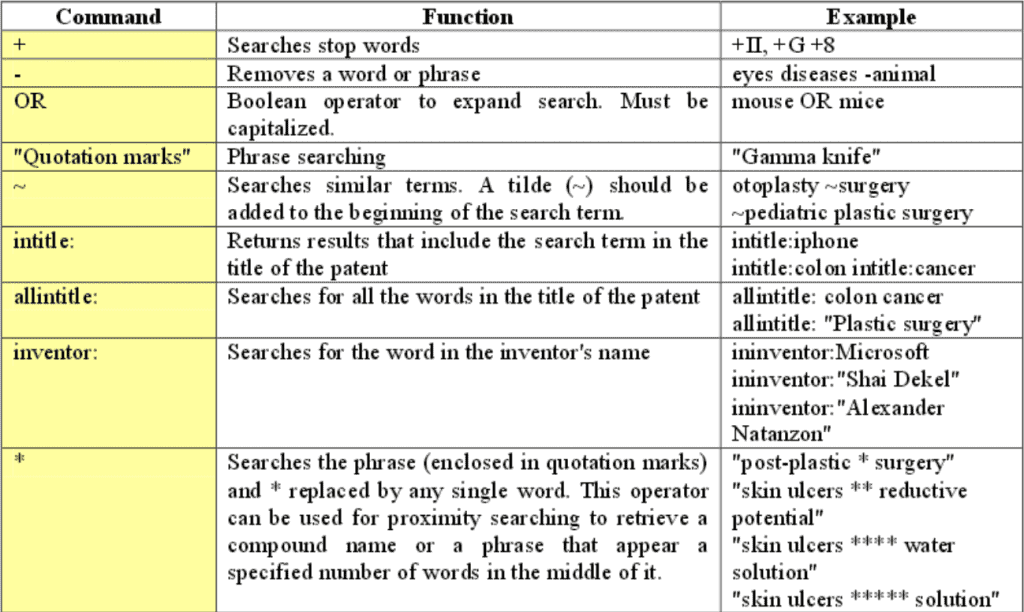
The goal is to find publications (which means patent document or non-patent literature document) that have at least one of the features and functionality of your invention so that you can hone in on the best classification of the invention.
STEP 5:Classification Searching: Determine Invention Classifications
The best way to find patent documents that are similar to your invention is to search within the proper patent classification. There are many different patent classification systems out there, so you will need to slowly become familiar with them as you start to gather inventions that are similar to your invention.This step can take quite a long time for someone not familiar with the USPTO search tools or navigating in the classification systems. If you’re doing it on your own, budget for at least 5 hours of time.There are many classifications – but it will become critical to determine which classes your invention falls into to assure you’re researching the correct publications. Here is an exhaustive list of classes numbered 0-1000.To keep things straightforward, I will talk only about just the US classification system. So, when looking at US patents, you can spot which class each patent is in easily, from the first page of the patent, see the red circle below: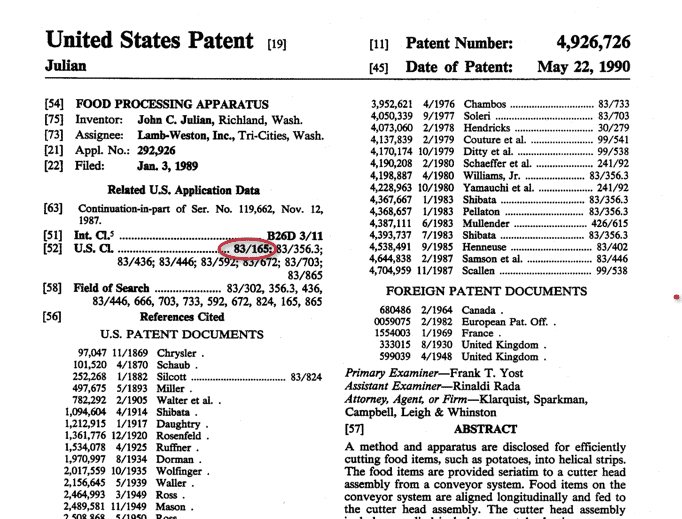
Here, you can see the “U.S. Cl” which means “United States Classification” is “83”. There are a lot of subclasses, but you’ve found the major class, which is defined by the USPTO as follows:Class 83 is the residual locus of patents directed to methods and machines for penetrating material, without substantial reshaping flow of such material, by means of (1) a solid tool, or fluid current, either of which applies mechanical deforming force to the material by direct physical contact therewith, the fluid current forcing the material against a solid tool whose edge defines the line of cut; (2) a heated solid tool which directly engages the material (to effect penetration thereof by melting, or by transmission of mechanical energy, or both); or (3) opposed, controlled fluid currents.(https://www.uspto.gov/web/patents/classification/uspc083/defs083.htm)
After you’ve confirmed that for each distinct feature/functionality of your invention that you’ve got the correct classification, you need to find the correct sub-classification(s) for your invention. By identifying sub-classifications, you will be able to refine your search to a manageable number of patent documents without spending months of time just reading. Subclass research will allow you to find a close brother/sister invention and then continue drilling down into the details of similar publications by following which patents the examiner cited as being close/similar. When the invention of a close patent publication was being examined at the USPTO, the examiner did their best search to see what they could find in terms of prior art. By using references/citations, you can use the hard work of the expert examiner. Here is a look back to our example—I’d start by researching the most recent references first: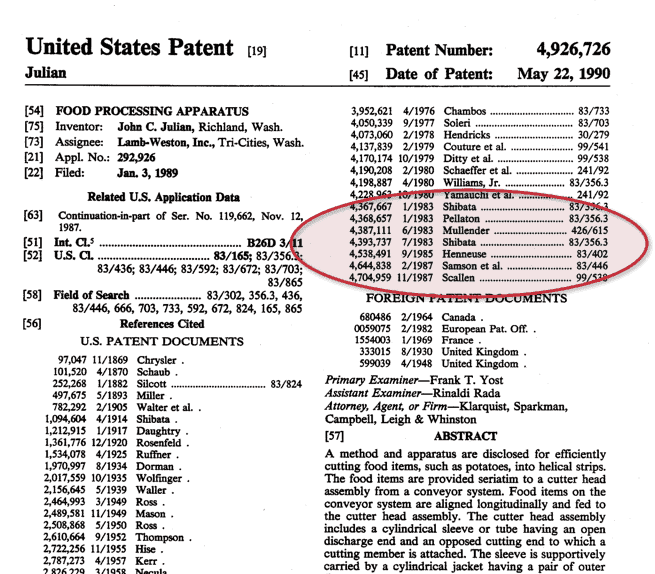
It should be noted that this process of classification will not be useful for non-patent documents/publications. Therefore, we will need to have an equally robust way of reviewing non patent literature.
Step 6: Non-Google Searches
Once the broad search is complete, it is very important to conduct searches in other search engines that may have access to domestic and foreign patent publications that Google may not. Here is a sample list of websites in which to conduct searches: Free Patents Online (FPO): https://www.freepatentsonline.com/
- This is a great tool (and is fast website too) for simple searches
- I’ve found this is good for recently issued patents too (Google can take a little while before they are available)
USPTO Search: http://patft.uspto.gov/netahtml/PTO/search-bool.html. This tool has a great drop-down for doing a general patent lookup or more specific/detailed search; some of the more popular drop-downs are:
- US Patent Number Search (if you know the patent number or publication number)
- Patent Date Search (if you know the date(s) of invention/publication)
- Patent Search by Inventor (name)
- Patent Search by Title
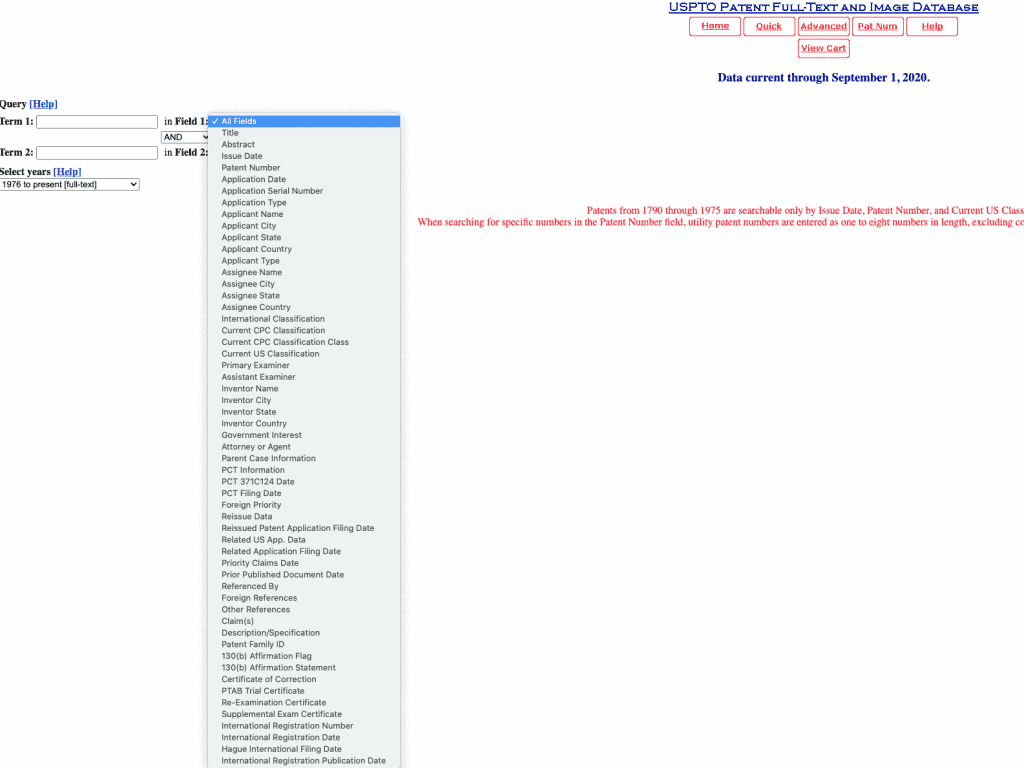
Best Country-Specific Natural Language Searches
- United States: http://patft.uspto.gov/netahtml/PTO/search-bool.html
- British: https://www.gov.uk/search-for-patent
- French: https://bases-brevets.inpi.fr/en/recherche-avanceeen.html
- German: https://www.dpma.de/english/search/index.html
- Chinese: http://www.pss-system.gov.cn
- Japanese: https://www.j-platpat.inpit.go.jp/web/all/top/BTmTopEnglishPage
- Korean: http://eng.kipris.or.kr/enghome/main.jsp
Multi-Country
- European Patent Office (EU) “Espacenet”: https://worldwide.espacenet.com/
- World Intellectual Property Organization (WIPO) “Patent Scope”: https://patentscope.wipo.int/search/en/search.jsf
- Patent Lens: https://www.lens.org/
We cannot rely on just Google to search for inventions. We need to assure we turn over every rock and seek out the best information possible. To do this, we actually go to these websites and perform distinct searches for each key feature and functionality. What’s Next? Legal OpinionNow that you have the tips on how to do a patent search, you should be well informed about the invention and the state of the art for the technology area that your invention is in.Let’s recap the 6 steps of patent search:
- STEP 1: Understand What a Patent Search is and What it is Not
- STEP 2: Invention Disclosure
- STEP 3: Identify 3-5 Key Features
- STEP 4: Begin Searching Broadly
- STEP 5: Classification Searching: Determine Invention Classification(s)
- Step 6: Non-Google Searches
After a robust patent search, the most crucial step is to analyze the results. A major drawback to doing your own free patent search is that you may not have all of the information you need. The kind of analysis needed here is legal. Not just anyone can do it, it requires a deep understanding of the statutory rules around patent law (35 USC 101, 102, and 103). In addition they need to know the lengthy case law history as it has evolved through the district, appeal, and supreme courts over the years.Remember, you have options on how to do a patent search. There are pros and cons to each option. At Bold Patents, we can help guide you through the patent search process or take it on ourselves. Contact our expert team today! 800-849-1913
—
Legal Note: This blog article does not constitute legal advice. Although the article was written by a licensed USPTO patent attorney there are many factors and complexities that come into patenting an idea. We recommend you consult a lawyer if you want legal advice for your particular situation. No attorney-client or confidential relationship exists by simply reading and applying the steps stated in this blog article.
